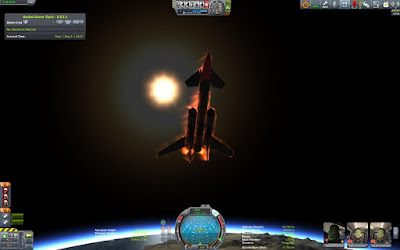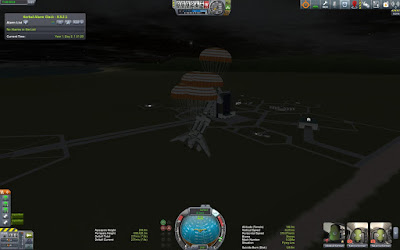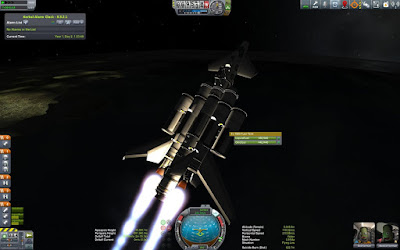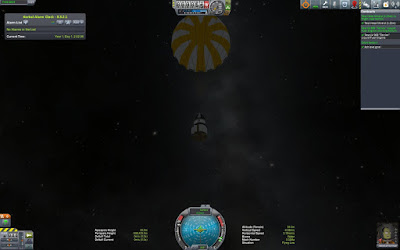After a
sufficient share of suborbital forays, which were more like elevator studies
(up, down, up, down, … yeah, probably the pure essence of the whole Kerbal
Space Program!), it was time for the first orbital flight. For this, I chose a
conventional staged rocket. I had a test contract for a higher orbit, higher
than the Starglider would have deltaV for.
In the meanwhile I had also figured out the “pod-problem”. A re-entry speed is only too high and leads to “splad” if the distance for slowing down via aerobraking is too short. Thus, all those vertical climbs into suborbit led to high speed vertical descends with very little time for braking by the air resistance of the atmosphere. Re-entry should rather follow a flat and long curve. I love how this game makes you learn by leading you to your own deductions.
In the meanwhile I had also figured out the “pod-problem”. A re-entry speed is only too high and leads to “splad” if the distance for slowing down via aerobraking is too short. Thus, all those vertical climbs into suborbit led to high speed vertical descends with very little time for braking by the air resistance of the atmosphere. Re-entry should rather follow a flat and long curve. I love how this game makes you learn by leading you to your own deductions.
- two phased re-entry: big empty fuel tanks help to slow down faster
And, what can I say, it fills me with pride to report that my first orbital flight went absolutely smoothly, no reverse-flight function whatsoever. A rare achievement indeed. And a lot of science points on the side; never forget to bring along all your science toys!
After this
foray, the orbital playing field was open, with plenty of tourist contracts.
This also gave me the opportunity to refine the Starglider from a suborbital
hopper to a true Orbiter. I also practiced re-entry a lot, finding the proper
descend curve and angle of attack.


- high angle of attack for re-entry
- Spacegliding down the rest
One time, I could point land the Orbiter with its parachutes on the runway. The Orbiter wings do not only sufficiently slow down the re-entry, they also allow for gliding and thus some limited aiming where to touchdown. It is a lot of fun to guide those half-planes-half-rockets.

- precise touchdown location
The only nuisance is the weird SAS-autopilot, who with bigger vessels like this would pendulum endlessly when steered. This is a mixed problem of the position of the piloting unit, as well of a too-weak torque in space or the limits of atmospheric flight (try a 90-degree turn at 600 m/s…).

- this approach was a close one
After some time and with more cash, I felt confident to reach out: Mün flyby. Some tinkering and pimping up of my Spaceglider with some staged fuel tanks squeezed out enough extra deltaV do just pull it off.

- going for a Mün flyby
Before this thing really went to Mün, I had to do a lot of test flights. Earlier, I worked a lot with the "reverse flight" option. However, this steals a lot of game time and game progress is lacking accordingly. This time, I simply took tourist contracts in order to finance every test flight. Once in orbit, I would see if I managed to save enough deltaV in order to get into the Mün sphere of influence (SOI). This, in turn, honed my skills for a proper ascend profile for this iteration of the Spaceglider class. Adding tanks changed center of mass and drag profile, after all: Any modified space craft is a new space craft.

- on Mun trajectory; very rewarding experience


- high angle of attack for re-entry
- Spacegliding down the rest
One time, I could point land the Orbiter with its parachutes on the runway. The Orbiter wings do not only sufficiently slow down the re-entry, they also allow for gliding and thus some limited aiming where to touchdown. It is a lot of fun to guide those half-planes-half-rockets.

- precise touchdown location
The only nuisance is the weird SAS-autopilot, who with bigger vessels like this would pendulum endlessly when steered. This is a mixed problem of the position of the piloting unit, as well of a too-weak torque in space or the limits of atmospheric flight (try a 90-degree turn at 600 m/s…).

- this approach was a close one
After some time and with more cash, I felt confident to reach out: Mün flyby. Some tinkering and pimping up of my Spaceglider with some staged fuel tanks squeezed out enough extra deltaV do just pull it off.

- going for a Mün flyby
Before this thing really went to Mün, I had to do a lot of test flights. Earlier, I worked a lot with the "reverse flight" option. However, this steals a lot of game time and game progress is lacking accordingly. This time, I simply took tourist contracts in order to finance every test flight. Once in orbit, I would see if I managed to save enough deltaV in order to get into the Mün sphere of influence (SOI). This, in turn, honed my skills for a proper ascend profile for this iteration of the Spaceglider class. Adding tanks changed center of mass and drag profile, after all: Any modified space craft is a new space craft.

- on Mun trajectory; very rewarding experience


No comments:
Post a Comment